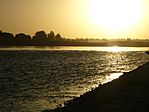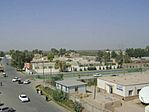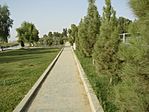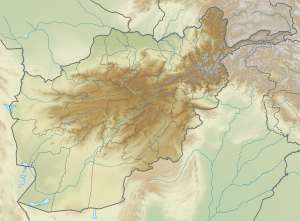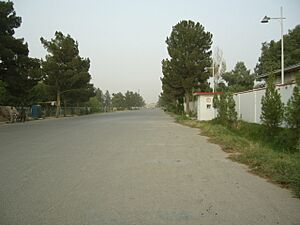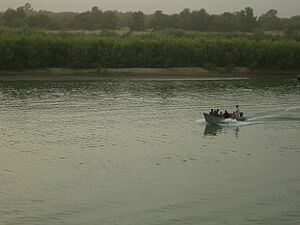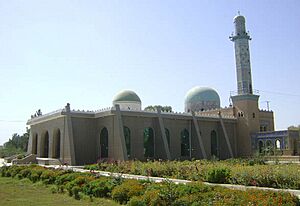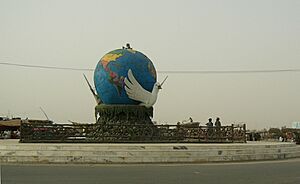Lashkargah facts for kids
Quick facts for kids
Lashkargah
لشکرگاه
Bost
|
|
|---|---|
|
City
|
|
|
From top, left to right: Ghaznavid fortress of Qala-e-Kohna; Sunset over the Helmand River; Lashkargah Mosque; Lashkargah streets; Mirwais Nika Park.
|
|
| Country | |
| Province | Helmand Province |
| Area | |
| • Land | 384 km2 (148 sq mi) |
| Elevation | 773 m (2,536 ft) |
| Population
(2006)
|
|
| • City | 201,546 |
| • Urban | 276,831 |
| Time zone | UTC+4:30 |
| Climate | BWh |
Lashkargah (Pashto: لښکرګاه; Persian: لشکرگاه), also known as Bost, is an important city in southwestern Afghanistan. It is the capital of Helmand Province. The city is located where the Arghandab River joins the Helmand River. In 2006, about 201,546 people lived there.
Lashkargah is connected by major roads to other cities like Kandahar to the east and Herat to the north-west. Most of the area around the city is dry and empty. However, there is farming near the Helmand and Arghandab rivers. Bost Airport is just north of where the two rivers meet. Lashkargah is a big trading center, making it Afghanistan's second-largest city in size, after Kabul.
In August 2021, after some fighting, the city was taken over by the Taliban. This made it the fourteenth provincial capital to be taken by them during that time.
Contents
History of Lashkargah
Lashkargah means "army barracks" in the Persian language. About a thousand years ago, it started as a town for soldiers. These soldiers would go with the Ghaznavid leaders to their winter capital, Bost. You can still see the ruins of the old Ghaznavid buildings along the Helmand River. Over many centuries, the city of Bost was attacked by different groups like the Ghorids and Mongols. However, the region was later rebuilt.
By the late 1500s, the city was ruled by the Safavid dynasty. In 1709, it became part of the Afghan Hotaki Empire. Later, in 1747, it became part of modern Afghanistan under the Durrani Empire. The British were in the city around 1840 during the First Anglo-Afghan War, but they left about a year later. The city remained peaceful for the next 100 years.
The modern city of Lashkargah was built in the 1950s. It was a base for American engineers working on a big irrigation project called the Helmand and Arghandab Valley Authority (HVA). This project helped bring water to dry areas. Lashkargah was designed with wide, tree-lined streets and brick houses. After the Soviet invasion of Afghanistan in 1979 and a long civil war, many of the trees were cut down, and walls were built around houses.
The Helmand irrigation project, from the 1940s to the 1970s, turned thousands of hectares of desert into farmland. This project built three large canals: the Boghra, Shamalan, and Darweshan. A special government agency, the Helmand and Arghandab Valley Authority (HAVA), was in charge of keeping these canals working.
After Soviet forces left Afghanistan in 1989, and the government fell in 1992, the city was taken by Mujaheddin forces. In the mid-1990s, the Taliban government took control. In late 2001, the United States armed forces removed the Taliban from power. From 2002, the city was occupied by the United States Marine Corps and other international forces.
In 2008, Taliban forces attacked the city, but the Afghan National Army and other troops defended it. This was shown in the documentary "Shepherds of Helmand." In 2011, foreign armies handed over security to the military of Afghanistan and Afghan National Police. The city has seen some fighting since then. In October 2020, the Taliban attacked the city again but later withdrew. On August 13, 2021, Lashkargah came under Taliban control after the Battle of Lashkargah.
Climate and Weather
Lashkargah has a hot desert climate. This means it gets very little rain. The temperatures can change a lot between summer and winter. The average temperature in Lashkargah is about 20.1°C (68.2°F). The city gets about 97 mm (3.8 inches) of rain each year.
Summers in Lashkargah start in mid-May and last until late September. They are very dry. July is the hottest month, with an average temperature of 32.8°C (91°F). January is the coldest month, with an average temperature of 7.6°C (45.7°F).
Helmand River and Nature
The Helmand River is the longest river in Afghanistan, stretching 1,150 km (710 miles). It starts in the Hindu Kush mountains and flows into Iran. One part of the river flows through Lashkargah, making it a nice place for picnics. The river is deep enough for swimming and boating, and you can rent boats.
Mirwais Neka Park was recently built along the riverbanks. On the other side of the river from the city, there is a large area of thick bushes and trees. Many types of trees, birds, mammals, and reptiles live there.
Places to Visit
The old Ghaznavid Empire fortress of Lashkari Bazar is just outside the city. To the south, the impressive ruins of Qala-e-Bost fortress can be found. It is located near where the Helmand and Arghandab Rivers meet, about a 30-minute drive south of Lashkargah. Qala-e-Bost is famous for its beautiful arch, which is shown on the 100 Afghani banknote (Afghanistan's money).
- Mosques
- Lashkargah Mosque is the main mosque in the city.
- Parks
- Mirwais Nika Park is located along the Helmand River.
- Mohammadd Rasul Akhondzada Park is in the center of the city.
- Baba-e-Millat Park is a very large park, covering seven hectares, also located on the Helmand River.
- There is also a Park for Females.
Population and Land Use
In 2006, the population of Lashkargah was about 201,546 people. By 2015, it was estimated to be around 276,831.
Lashkargah is a major trading and transport center in southern Afghanistan. Because it is located where the Helmand and Arghandab rivers meet, it has a lot of water. Farming uses the most land in the city, about 61%. Most homes are in the central parts of the city.
Education and Media
The level of education in Lashkargah was very good in the 1960s and 70s. Students were known for being smart and hard-working. They often got into good universities.
Today, there are about 27 schools in Lashkargah. There is also a teacher's training institute and an agricultural school. The Lashkargah Technical, Agricultural and Veterinarian Institute was started in 2011. Lashkargah also has several higher education places:
- The Public Helmand University was founded in 2008. It has four main study areas: Agriculture, Engineering, Education, and Veterinary studies.
- The Bost Institute of Higher Education is a private school started in 2012. It offers courses in law, engineering, and business.
- The Bost Agricultural University was opened in 2007 and focuses only on agriculture.
Many students in the city also attend computer and English language classes.
Besides official groups, young people in Lashkargah are very active in cultural and educational activities. There are groups like the Helmand Youth Organization and the Bost Cultural Society. Students and cultural groups also create and update various cultural and educational websites.
Media use has grown a lot in Lashkargah over the last ten years. Many people listen to the radio, watch television, and use the internet. Several radio stations broadcast in Lashkargah, including Tamadoon Radio and Sabawoon Radio. There is also a local TV channel called Bost Television.
City Improvements
Lashkargah has seen many improvements in recent years. New roads, markets, and homes have been built. Many Afghans are moving from their tribes to cities like Lashkargah. Government projects have given land to people, making the city bigger. Modern buildings are now more common than traditional mud houses.
The former Governor of Helmand province, Gulab Mangal, helped fund many city improvements. The Governor's office and Justice Department were renovated. New Police Headquarters and an Eidgah (a place for Eid prayers) were also funded. Unlike many parts of Afghanistan, the roads in Lashkargah are usually paved. International groups have also helped build schools, roads, and parks.
In 2005, a project funded by USAID planned to build six water reservoirs in Lashkargah. This would help provide fresh water to the city, which had been without it for 30 years because the Helmand River was polluted.
In 2010, the British Army and local workers built a road called Route Trident. This road connects Lashkargah to the more developed city of Gereshk to the north.
A current project aims to improve the "Lashkargah Bost Airport and Agriculture Center." This project will build a new agricultural center and an Industrial Park. It will also fix and update Bost Airport.
Sports and Activities
Football and cricket are the most popular sports in Lashkargah. The Lashkargah Football Stadium was rebuilt in 2006 and can hold about 10,000 people. There are 13 registered cricket teams that play at the new Karzai Stadium, which was finished in 2009.
Bodybuilding is also popular among young people in Lashkargah. There are several gyms in the city. Aziz Ahmad Nikyar won the "Mr. Afghanistan" title in 2006 and also competed in the Asian Games that year. Other popular sports in Lashkargah include Taekwondo, Boxing, Snooker, and Volleyball.
Famous People from Lashkargah
- Tamim Ansary, an author
- Abu al-Fath al-Busti (942–1010), a famous Persian poet
- Muhammad ibn Hibban al-Busti (about 884–965), a Muslim scholar
- Ehsan Aman (born 1959), a singer
- Hasan Maymandi, a governor of Bust in the 10th century
See also
 In Spanish: Lashkar Gah para niños
In Spanish: Lashkar Gah para niños



